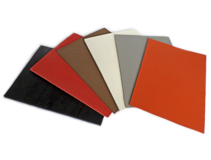
Elastomers
An Elastomer is a polymer with the physical property of elasticity. Elastomer is a term derived from elastic polymer, which is often used interchangeably with the term rubber. Each of the monomers which link to form the polymer is usually made of carbon, hydrogen, oxygen and or silicon. Elastomers are usually thermosets requiring a cure process of rubber involving heat and the addition of sulfur or other equivalent curatives. In addition elastomers might also be thermoplastic.
View the list of elastomers below.
Elastomers include:
BUNA-N RUBBER (NITRILE, NBR)
Buna-N is a synthetic rubber that has good resistance or oils and solvents,aromatic and aliphatic hydrocarbons, petroleum oils and gasoline over a wide range of temperature. It also has good resistance to caustics and salts but only fair acid resistance. It is poor in strong oxidizing agents, chlorinated hydrocarbons, ketones and esters. It is suitable over a temperature range of approximately -22°F to 250°F.
NEOPRENE (CHLOROPRENE, CR)
Neoprene is a synthetic rubber that is suitable for use against moderate acids, alkalies and salt solutions. It has good resistance to commercial oils and fuels. It is very poor against strong oxidizing acids,aromatic and chlorinated hydrocarbons. Its suitable temperature range is from -40°F to 250°F.
EPDM (ETHYLENE PROPYLENE)
This polymer has superior resistance to ozone, heat and sunlight applications. It has good resistance to water and steam EPDM is available in black, white (FDA) and purple.It is sulfur and peroxide curable. Temperature range from -30°F to 350°F.
VITON (FLUOROCARBON, FPM)
Viton elastomer has good resistance to aggressive oils, fuels,chlorinated solvents, aliphatic and aromatic hydrocarbons and strong acids. It is not suitable for use against amines, esters, ketones or steam. Temperature range from -22°F to 450°F. Available in Black and Brown.
SILICONE (SI)
Silicone rubber has high temperature properties as well as excellent tensile strength, compression set and is a fungus resistance material. It has good resistance against many chemicals, including acids, oxidizing chemicals and ammonia. Silicone is not, however, suitable for use against steam, aliphatic and aromatic hydrocarbons. Available in red, gray and white (FDA) Temperature range from -65°F to 450°F.
RED RUBBER
An economical Red Rubber sheet with a fabric finish used in Low-Pressure applications with no Oil Resistance requirements. Tensile of 500 psi., hardness of 80 shore ‘A’ Temperature range of -4°F to 175°F.
SBR (STYRENE-BUTADIENE)
SBR is a synthetic rubber that has excellent abrasion resistance and has good resistance to weak organic acids, alcohols, moderate chemicals and ketones. It is not good in ozone, strong acids, fats. Oils, greases and most hydrocarbons. Temperature range from -22°F to 170°F.
C.I.RUBBER (SBR)
C.I.Rubber is a polyester reinforced SBR rubber See SBR for details.
AFLAS
Aflas Fluoroelastomer is a high temperature resistant material,with excellent resistance to acids, bases, high PH corrosion inhibitors, sour gas and oil, high pressure steam and alcohols. It is unusual in that it also has fair resistance to aromatic solvents and fuels, as well as ketones and low molecular weight esters and ethers. Aflas is not recommended for service in chlorinated solvents, Freon refrigerant,and tetrahydrofurane solvent. Temperature range from -10°F to 675°F.
HYPALON
Hypalon has good acid, alkali and salt resistance, It resists weathering, sunlight, ozone, oils and commercial fuels such as diesel and kerosene. It is not good in aromatics or chlorinated hydrocarbons and has poor resistance against chromic acid and nitric acid. Temperature range from -20°F to 275°F.
VEGETABLE FIBER SHEET
Vegetable fiber sheet is a tough pliable gasket material manufactured by paper making techniques utilizing plant fibers and a glue-glycerine impregnation. It is widely used for sealing petroleum products, gases and a wide variety of solvents. Its maximum temperature limit is 250°F. if a more compressible material is required, a combination cork-fiber sheet is available. The cork-fiber sheet has the same maximum temperature limitation as the vegetable fiber sheet.
Contact us for any further questions regarding Elastomers.
